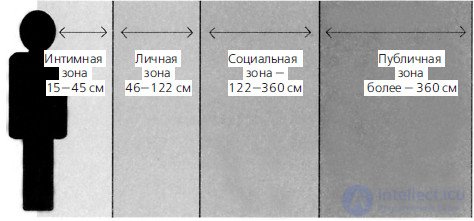Now let's discuss the radius of the “air bubble” that surrounds a middle class representative living in the suburbs in countries such as Australia, New Zealand, the United Kingdom, Canada, North America, Northern Europe, Scandinavia, or in countries under strong western influence, in Singapore, Iceland or on the island of Guam. The country in which you live may be more or less than those about which we will speak, but, in principle, nothing different from them. Children learn spatial limitations by the age of twelve. Private space can be divided into four spatial zones.
1. The intimate zone - 15-45 cm. This zone is very important because it is perceived by a person as personal property. Only the closest spouses, parents, lovers, children, close friends, relatives, pets can enter this zone. Here you can select some subzone - less than 15 cm from the body. It is possible to invade here only during an intimate physical contact.
2. Personal zone - 46-122 cm. This is the distance at which we prefer to stay away from other people at parties, during communication or at work.
3. Social zone - 122-360 cm. At such a distance we keep from strangers, plumbers and carpenters, repairing our homes, postmen, salespeople, new employees - in short, from everyone we know not well enough.
4. Public zone - more than 360 cm. Addressing a group of people, we prefer to stand at such a distance.
These distances decrease when two women communicate and increase if two men communicate.

Sizes of spatial zones

Comments
To leave a comment
Body language
Terms: Body language